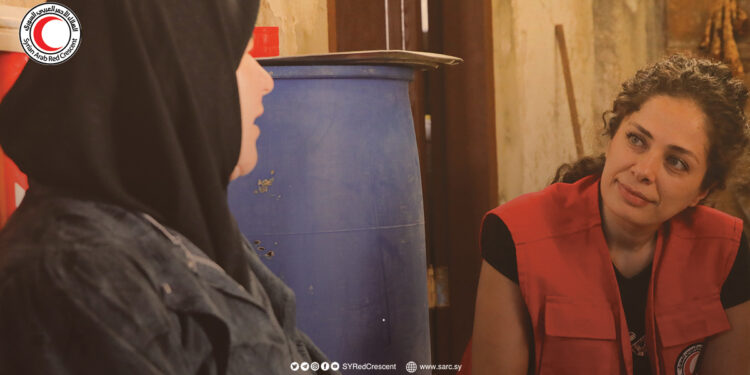Waking up in Syria today means looking at a bleak future ahead of you. Syria faces many challenges that make it one of the world’s most complex humanitarian and protection emergencies. After 12 years of crisis during which the country has lost 42 places on the Human Development Index, most Syrians face a context of continuing humanitarian decline. The country still has the largest number of internally displaced people in the world, and the highest number of people in need since the beginning of the crisis. Humanitarian and economic indicators continue to deteriorate; basic services are collapsing.
In addition, the recent earthquake that has hit the country and compounded the already dire humanitarian crisis pushing the country to the brink.
and with each new crisis, Syrian families are forced to reorganize their priorities to get back on their feet. So how can the Syrian Arab Red Crescent help them take the first steps?
Khawla is a sixty-year-old mother who lives in Karnaz in rural Hama. Her house was badly damaged during the crisis years and months after it was restored by the Syrian Arab Red Crescent, the 6 February earthquake has again caused cracks in the walls, but it is still safe to live in, she says.
“We used to cover the exposed parts of the walls to have some privacy and security, and in winter rainwater flooded the kitchen and rooms,” Khawla explains the state of her house before it was restored.
It is the house she has lived in for 50 years and where she gave birth to 10 children, but now she lives with a daughter who supports her.
The house’s renovation included reinforcing and painting the walls, renovating the kitchen and shower room, and installing a water tank. It is one of 91 houses (inhabited by 637 people) that will be rehabilitated in Hama in 2022 and 2023.
Khawla says that “providing food, water, and medicine is a hardship that becomes more difficult every day”, without hiding her fear of the days ahead when the small income her daughter receives as a laborer on the agricultural land will not be enough to cover her basic needs.
In A-Nazeheen neighborhood in Homs, Ammar Hamdan has regained a sense of security after renovating his house and returning to it.
However, he is also concerned about earning a living for his family of five and works as an employee.
SARC helped Ammar renovate his house by installing doors and windows, a water tank, and refurbishing the sanitary facilities as part of a project to restore the houses of 173 families in Homs in 2021. He also received a cash grant.
The fifty-year-old father says: “Returning home eased the burden of paying rent on my shoulders, but the cost of living is doubling every day and I do not know how to provide for my daughters’ education, heating, and alternatives to electricity.”
This also worries Youssef (Abo Yazan), who works as a carpenter in a workshop in Homs after receiving a grant from the Syrian Arab Red Crescent to buy equipment. He says: “My children’s education is my priority”
Youssef worked for a daily wage. After buying some equipment, he got his projects while paying a percentage for the owner of the workshop, which improved his income well, he says, but the increase in material prices affects the source of labor and sometimes causes his losses.
Youssef, 52 years old, suffers from thalassemia and works hard to provide for his family of six, despite doctors’ recommendations not to exhaust himself, but “there is no room for rest”, as he puts it, especially after losing his house, land, and workshop during the crisis and being forced to rent a house and switch between several jobs. Before receiving the grant in 2023 as one of 238 families supported by the International Committee of the Red Cross.


